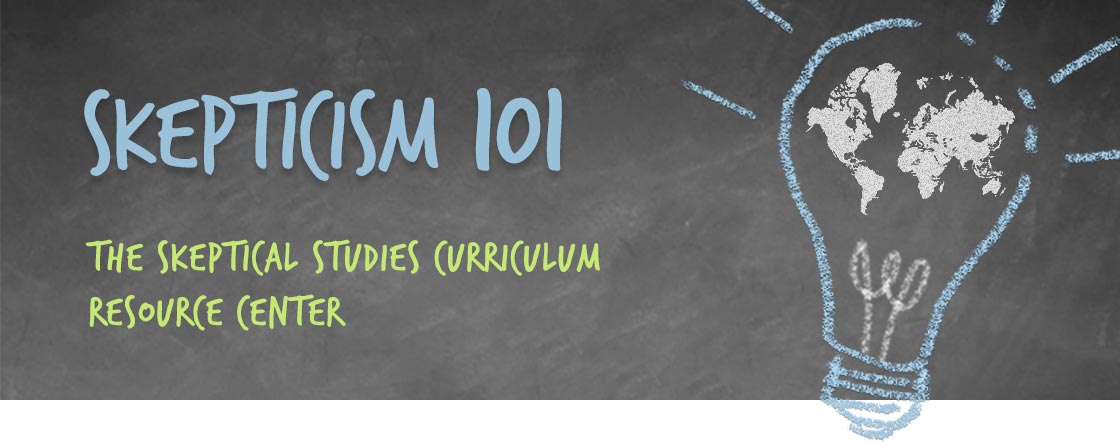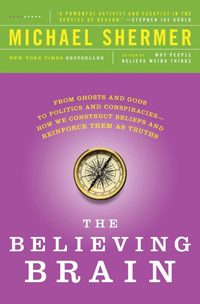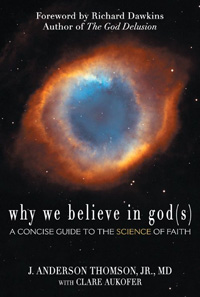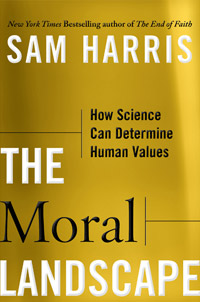You Are Browsing Resources
for the Academic Discipline of:
neuroscience
This course was taught at Florida State College at Jacksonville during the spring 2013 semester.
Excerpt from Syllabus
An interdisciplinary study of selected topics in the biological and physical sciences and their impact upon man and society, with the course format including seminar, discussion and projects. Topics will vary…. genetics, tissue culture, space, Malthusian theory, light, sound, and mechanics. This course will provides students with a unique opportunity to examine many common pseudoscientific fallacies, learn how the human brain has evolved to encourage paranormal beliefs, and challenge the students to confront their own biases as they apply the scientific method to their own beliefs through in-class activities, experiments, and research projects.
DOWNLOAD THIS RESOURCE
(150 kb PDF)
This is an overview of the biological influences on sex, love, and attraction. It includes research on the types of “love” and which brain areas and chemicals are involved in those subjective experiences. This presentation was created by Randy Ludwig for Dr. Michael Shermer’s course, “Evolution, Economics & the Brain” taught at Claremont Graduate University during the spring 2011 semester.
DOWNLOAD THIS RESOURCE
(1.6 MB Powerpoint Presentation)
This book was required reading for the following courses: (1) “Skepticism 101: How to Think Like a Scientist (Without Being a Geek)” taught by Michael Shermer during the fall 2011 and (2) “Evolution, Economics, and the Brain” taught by Michael Shermer during the spring 2012.
In this, his magnum opus, Dr. Michael Shermer presents his comprehensive theory on how beliefs are born, formed, nourished, reinforced, challenged, changed, and extinguished. This book synthesizes Dr. Shermer’s 30 years of research to answer the questions of how and why we believe what we do in all aspects of our lives, from our suspicions and superstitions to our politics, economics, and social beliefs. In this book Dr. Shermer is interested in more than just why people believe weird things, or why people believe this or that claim, but in why people believe anything at all. His thesis is straightforward:
“We form our beliefs for a variety of subjective, personal, emotional, and psychological reasons in the context of environments created by family, friends, colleagues, culture, and society at large; after forming our beliefs we then defend, justify, and rationalize them with a host of intellectual reasons, cogent arguments, and rational explanations. Beliefs come first, explanations for beliefs follow.”
Dr. Shermer also provides the neuroscience behind our beliefs. The brain is a belief engine. From sensory data flowing in through the senses the brain naturally begins to look for and find patterns, and then infuses those patterns with meaning. The first process Dr. Shermer calls patternicity: the tendency to find meaningful patterns in both meaningful and meaningless data. The second process he calls agenticity: the tendency to infuse patterns with meaning, intention, and agency.
We can’t help believing. Our brains evolved to connect the dots of our world into meaningful patterns that explain why things happen. These meaningful patterns become beliefs. Once beliefs are formed the brain begins to look for and find confirmatory evidence in support of those beliefs, which adds an emotional boost of further confidence in the beliefs and thereby accelerates the process of reinforcing them, and round and round the process goes in a positive feedback loop of belief confirmation. Dr. Shermer outlines the numerous cognitive tools our brains engage to reinforce our beliefs as truths and to insure that we are always right.
Interlaced with his theory of belief, Dr. Shermer provides real-world examples of belief from all realms of life, and in the end he demonstrates why science is the best tool ever devised to determine whether or not a belief matches reality. —Shop Skeptic
BUY THIS BOOK
from Shop Skeptic
Michael Shermer gave a lecture on this book at the California Institute of Technology.
BUY THE DVD
from Shop Skeptic
This book was required reading for Dr. Innes Mitchell’s course, “Perspectives on Atheism” taught at St. Edwards University during spring 2012.
In this groundbreaking work, J. Anderson Thomson, Jr., with Clare Aukofer, offers a succinct yet comprehensive study of how and why the human mind generates religious belief. Dr. Thomson, a highly regarded psychiatrist known for his studies of suicide terrorism, investigates the components and causes of religious belief in the same way any scientist would investigate the movement of astronomical bodies or the evolution of life over time, that is, as a purely natural phenomenon. Providing compelling evidence from cognitive psychology and the neurosciences, he presents an easily accessible and exceptionally convincing case that god(s) were created by man, not vice versa. With this volume, Dr. Thomson establishes himself as a must-read thinker and leading voice on the primacy of reason and science over superstition and religion.—Amazon
BUY THIS BOOK
from Amazon
This presentation depicts the history of academic thought on voter turnout and shows how recent neuroscience has changed the prevailing wisdom on the subject. While political science scholars of the 70’s and 80’s believed voters were rational calculators, neuroscience has shown that emotion and narrative play a strong role in this process. This presentation was created by Michael Mermelstein for Dr. Michael Shermer’s course, “Evolution, Economics & the Brain” taught at Claremont Graduate University during the spring 2012 semester.
DOWNLOAD THIS RESOURCE
(182 kb Powerpoint Presentation)
This course was taught at Claremont Graduate University during the spring 2012 semester.
Excerpt from Syllabus
Evolution, Economics, and the Brain is a doctoral-level Transdisciplinary Course designed to address large issues in which students employ knowledge and research protocols from many different disciplines to shed new light on specific problems. One of the books assigned—Steven Pinker’s The Better Angels of Our Nature—integrates evolution, history, anthropology, sociology, psychology, economics, and political science to explain a single phenomenon: the decline of violence. It is a model work in transdisciplinary integration.
A transdisciplinary and integrative overview of evolutionary theory, evolutionary economics, and neuroscience (“Evolution, Economics, and the Brain”) that includes a brief history and science of evolutionary theory, along with the evolution-creationism controversy and how it evolved in the context of American history and culture. As well, the application of evolutionary theory will be considered in its integration into psychology, anthropology, ethics, and economics. The course also includes an introduction to behavioral neuroscience and will focus on teaching students how new findings in the brain sciences can inform their work in the social sciences and humanities. For example: How reward acquisition is affected by risk; Why humans are typically risk-averse and when they are not; Hyperbolic discounting of future rewards; How interpersonal trust is built and maintained; How “rational” vs. “irrational” decisions are made; The basis for cooperation and aggression; The reason people punish others; The role of hormones in decisions; The basis for social norms or ethics; The sense of justice; The basis for love and hate and how these effect decisions; War and peace; Human nature; The decline of violence; The humanitarian and rights movements; and more.
DOWNLOAD THIS RESOURCE
(338 kb PDF)
Synthesizing thirty years of research, Michael Shermer upends traditional thinking about how humans form beliefs about the world. Simply put, beliefs come first, and explanations for beliefs follow. The brain, Shermer argues, is a belief engine. Using sensory data that flow in through the senses, the brain naturally looks for and finds patterns—and then infuses those patterns with meaning, forming beliefs. Once beliefs are formed, our brains subconsciously seek out confirmatory evidence in support of those beliefs, accelerating the process of reinforcing them. Shermer provides countless real-world examples of how this process operates, from politics, economics, and religion to conspiracy theories, the supernatural, and the paranormal.
DOWNLOAD THIS RESOURCE
(285 MB Powerpoint Presentation)
The Origins of Morality and How to be Good Without God
In The Science of Good and Evil, a lecture based on the third volume in his trilogy on the power of belief, Dr. Shermer tackles two of the deepest and most challenging problems of our age: (1) The origins of morality and (2) the foundations of ethics. Does evil exist, and if so, what is the nature of evil? Is it in our nature to be moral, immoral, or amoral? If we evolved by natural forces then what was the natural purpose of morality? If we live in a determined universe, then how can we make free moral choices? Why do bad things happen to good people? Is there justice in the world beyond the social order? If there is no outside source to validate moral principles, does anything go? Can we be good without God? In this stunning conclusion to an intellectual journey into the mind and soul of humanity, Dr. Shermer peels back the inner layers covering our core being to reveal a complexity of human motives—selfish and selfless, cooperative and competitive, virtue and vice, good and evil, moral and immoral—and how these motives came into being as a product of both our evolutionary heritage and cultural history, and how we can construct an ethical system that generates a morality that is neither dogmatically absolute nor irrationally relative, a rational morality for an age of science.
DOWNLOAD THIS RESOURCE
(69 MB Powerpoint Presentation)
Taken from the chapter in his book The Believing Brain on the psychology of political beliefs, Dr. Shermer considers how belief systems operate in the realm of politics, economics, and ideologies. He reviews the research on why people vote Republican or Democrat, why we are so predictable in our political beliefs that if you know where someone stands on, say, abortion, you can predict where they stand on a number of other political issues, and what these political beliefs say about the nature of human nature.
DOWNLOAD THIS RESOURCE
(34 MB Powerpoint Presentation)
This book was required reading for the following courses: (1) “Evolution, Economics, and the Brain” taught by Michael Shermer, and (2) “Knowledge, Value & Rationality” taught by Peter Boghossian.
Sam Harris’s first book, The End of Faith, ignited a worldwide debate about the validity of religion. In the aftermath, Harris discovered that most people—from religious fundamentalists to nonbelieving scientists—agree on one point: science has nothing to say on the subject of human values. Indeed, our failure to address questions of meaning and morality through science has now become the most common justification for religious faith. It is also the primary reason why so many secularists and religious moderates feel obligated to “respect” the hardened superstitions of their more devout neighbors.
—Amazon
In this explosive new book, Sam Harris tears down the wall between scientific facts and human values, arguing that most people are simply mistaken about the relationship between morality and the rest of human knowledge. Harris urges us to think about morality in terms of human and animal well-being, viewing the experiences of conscious creatures as peaks and valleys on a “moral landscape.” Because there are definite facts to be known about where we fall on this landscape, Harris foresees a time when science will no longer limit itself to merely describing what people do in the name of “morality”; in principle, science should be able to tell us what we ought to do to live the best lives possible. Bringing a fresh perspective to age-old questions of right and wrong and good and evil, Harris demonstrates that we already know enough about the human brain and its relationship to events in the world to say that there are right and wrong answers to the most pressing questions of human life. Because such answers exist, moral relativism is simply false—and comes at increasing cost to humanity. And the intrusions of religion into the sphere of human values can be finally repelled: for just as there is no such thing as Christian physics or Muslim algebra, there can be no Christian or Muslim morality.—Skeptic
BUY THIS BOOK
from Shop Skeptic












